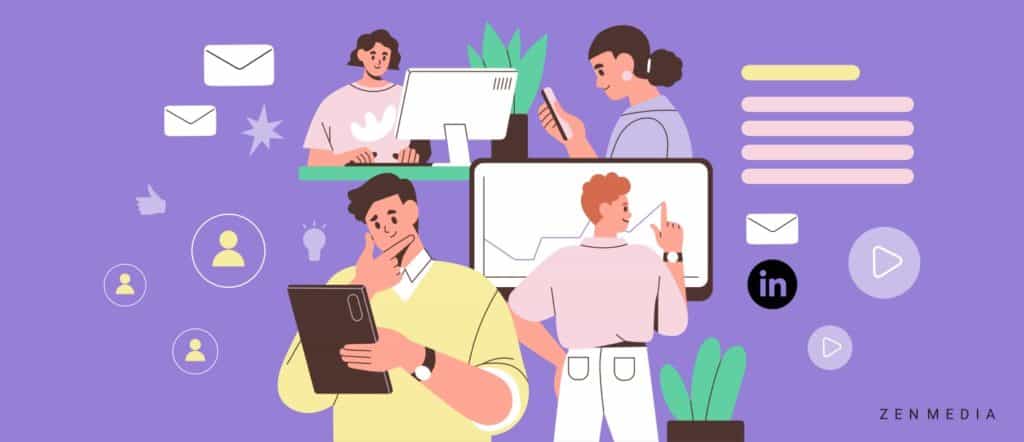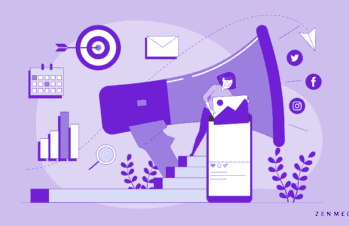B2B Marketers are responsible for building awareness, but we are also the gatekeepers of quality lead generation that our sales teams depend on. But to generate quality leads, marketers need to know their audience segments, the best practices for their preferred platforms, and the channels through which they’ll have the most success.
As for the best B2B platform, LinkedIn continues to be a top contender for B2B marketers to communicate with their audiences. Four out of five people on LinkedIn reportedly drive business decisions in their company—and brands see up to a two-times higher conversion rate on LinkedIn compared to other social platforms.
So how can B2B marketers plan a successful lead generation campaign on LinkedIn in 2023? Read on.
What is B2B lead generation?
An essential part of any digital marketing campaign, leads represent the first-party data you collect directly from customers—emails, phone numbers, product preferences, etc. To generate leads, marketers use a variety of inbound marketing tactics to build visibility, awareness, and interest in potential prospects. Using social media, search-engine-optimized blog posts, paid ads, email marketing, and more, marketers leverage lead generation to identify prospects most likely to convert.
Essentially, B2B lead generation is the first step in the buyer’s journey. When marketers talk about “capturing” leads, it means collecting the names and contact information of potential buyers, and tracking their journey through the sales funnel with the goal, of course, of increasing revenue and sales.
Related reading: 9 Key Lead Generation Strategies for B2B SaaS Companies
Lead generation versus demand generation
Lead generation and B2B demand generation are interwoven and often mistaken for one another. Both work to instill interest in a brand’s products or services, just in slightly different ways. Lead generation is focused on identifying potential customers and nurturing relationships with those prospects, while demand generation is about creating awareness and interest in your products and services.
Both lead generation and demand generation require similar efforts like identifying target markets, conducting research, and developing strategies. However, demand generation often requires more time and significant research to truly understand what drives people to take interest in your brand. If you’re generating new leads, you don’t necessarily want to spend a ton of time searching for perfect lead-enticing information because you’re casting a broader net. Lead generation focuses on generating leads with specific capture tactics—like a free downloadable e-book, a set of free Photoshop filters, or something of value to your audience—in exchange for their contact information.
Using effective lead gen strategies on LinkedIn, brands can benefit from connecting with their audience early in the sales funnel to create frequent touchpoints via newsfeed posts, ads, personalized cold messages, newsletters, and more. In fact, brands have seen a 33% increase in purchase intent from ad exposure on LinkedIn.
With that in mind, here are our top nine tips for developing a LinkedIn lead generation strategy:
- Create a LinkedIn company page.
- Create LinkedIn groups.
- Keep up a consistent presence.
- Organize LinkedIn webinars and events.
LinkedIn lead generation strategy tips
1. Create a LinkedIn company page.
Company pages allow businesses to create a profile for themselves on the professional networking site. A company page gives users access to information about the company and the people behind it. Most B2Bs we work with have a company page already, but oftentimes the page will be relatively blank and updated infrequently, reducing its value.
2. Create LinkedIn groups.
The biggest difference between LinkedIn and other social networking sites is the purpose behind each individual group. While Facebook and Twitter are designed to help you find and communicate with old classmates, friends, family, and others with shared interests, LinkedIn is built around helping professionals grow their careers. To this end, there are numerous groups tied to specific industries, job titles, and more.
Brands can leverage these groups by joining the ones that are relevant to their company and by creating their own groups. Brands can create groups that appeal to their ideal customers as a means to connect with prospects and get feedback on their offerings, as well as groups that help them source talent and improve staffing.
3. Keep up a consistent presence.
Just like all of your other social media sites, LinkedIn requires consistency. If you post an article once a week and then log out, you’re not establishing yourself as a consistent presence. It takes an average of five to seven brand impressions for someone to even remember your brand—and 27 of them to convert them into a customer.
4. Organize LinkedIn webinars and events.
While live events came back with some degree of success, in 2021 and 2022, webinars and LinkedIn events are still a popular and affordable way to build brand recognition, credibility, and a following. These types of live presentations allow you to connect directly with your audience, answer questions in real time, and build a rapport with prospects and current clients as well.
Related reading: Four Reasons To Market Your Business With Webinars
LinkedIn lead gen paid ads tips
Now that you’ve got a company page with a consistent presence, have joined relevant groups (and maybe created one of your own), and have considered live events and webinars, it’s time to talk about the foundation of a strong lead gen LinkedIn strategy: PPC paid advertising.
We have 5 key tips to help your LinkedIn B2B paid ads campaign a success:
- Retarget your audience based on the content that resonates with them.
- Funnel followers to your landing pages and lead magnets.
- Create LinkedIn display ads.
- Use LinkedIn lead gen forms.
- Don’t forget to follow up.
- Retarget your audience based on the content that resonates with them.
Audiences can be segmented into groups based on interests, demographics, job roles, location, beliefs, and more. And you can also target each group individually based on how they’ve engaged with your brand previously. Let’s say you want to send personalized emails to someone who recently shared a blog post about your product category. You could do this by targeting those individuals based on the B2B content they engaged with on your company page.
Beyond using their behavior to retarget them, you can use data on your audience’s behavior as a basis for targeting those who haven’t yet interacted with your brand, identifying your top-performing LinkedIn posts, and creating a cadence of content on similar topics or using similar writing strategies.
- Funnel followers to your landing pages and lead magnets.
Don’t pass up opportunities to market your products and services, but make sure you do it strategically. Also, keep in mind that LinkedIn is about networking, not selling. So don’t try to exclusively use the platform to pitch your wares. Consider how you can use your paid ad efforts on LinkedIn to better prepare you to engage with your leads. For instance, you can offer an exclusive piece of content in exchange for their participation in a survey, which will give you more data and insights to follow up with them on further down the funnel.
- Create LinkedIn display ads.
By adding display ads to your B2B marketing strategy, you can target specific leads based on company, job role, and company size. The more targeted your ads are, the higher quality your prospects will be. The key here is making sure that whatever you display really resonates with your key audience so that the static ad in the corner or sidebar of their screen compels them to take interest (rather than annoying them).
- Use LinkedIn lead gen forms.
When LinkedIn members click on your ad, their profile data automatically populates a form they can submit with one click. They’ll save time and effort, and you’ll get more accurate and complete information about qualified leads.
- Don’t forget to follow up.
The best way to keep prospects interested is to provide value every single time you interact with them. This includes sending emails, follow-up calls, and even making sales. But it also means remembering the extent of those touchpoints. You may not see the fruits of your labor for months—or longer. (Seriously, some B2B sales cycles are that long!) But if you invest the time in following your prospect through the sales funnel from lead gen to conversion, you will see a positive impact on your pipeline.
Following these tips, B2B marketers will be able to generate quality leads from LinkedIn for their brand. Generating those leads is the first step into the sales funnel for many prospects and a crucial one for your company’s sales team to identify qualified leads, avoiding wasted time and effort on everyone’s part. If you’re looking for some help in making B2B LinkedIn lead generation strategies work for your brand, reach out. Our experts would love to help your brand succeed on LinkedIn.





